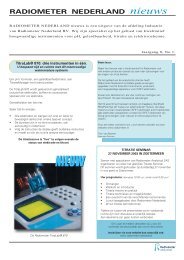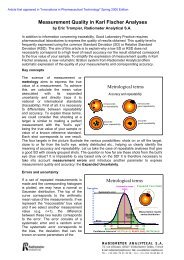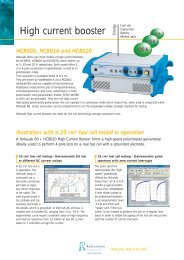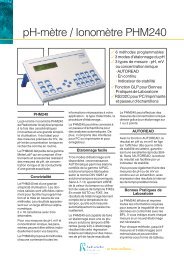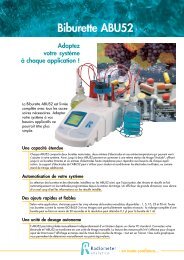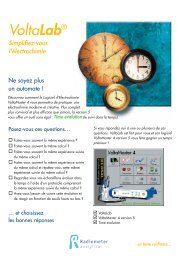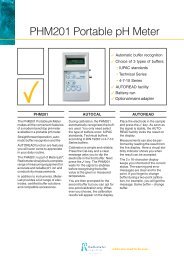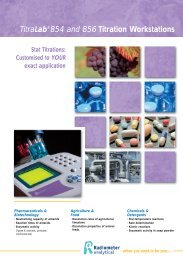Register your product now - Radiometer Analytical
Register your product now - Radiometer Analytical
Register your product now - Radiometer Analytical
You also want an ePaper? Increase the reach of your titles
YUMPU automatically turns print PDFs into web optimized ePapers that Google loves.
The “D/A OUT” socket (4)A DC voltage signal (0 to +5000 mV, resolution: 1.2 mV) is output at the centralcontact of this BNC coaxial socket. The socket shielding is connected to theelectrical zero.Application: The EDI101 electrode rotating speed can be controlled from thepotentiostat by connecting the CTV101 (sockets “EXTERNAL CONTROL” and“0-5 V”) to the “D/A OUT” socket of the PGZ potentiostat or by connecting theRDS010 to the “D/A OUT” socket of the PST050. The EDI10000 electrode rotatingspeed can also be controlled from the potentiostat by connecting theTACHYPROCESSOR (sockets “EXTERNAL CONTROL” and “0-5 V”) to the“D/A OUT” socket of the PGZ.The “A/D IN” socket (5)An additional voltage signal (-5000 mV to +5000 mV) coming from a pH-meterfor example, can be measured at this BNC socket (resolution: 152.5 µV). Themeasurement is synchronised with the I current and E potential measurements.The socket central contact corresponds to the input signal and the socket shieldingis connected to the electrical zero. This socket has an input impedance of 10MOhm.Connections to the electrodes (6)The “WORK” socket: PL259 type coaxial socket to be connected to the workingelectrode of the electrochemical cell. In almost all applications, the workingelectrode is connected to this socket.. central contact: working electrode at low impedance. shielding: connected to the analog electrical zeroThe “SENSE” socket: BNC type coaxial socket to be connected to the workingelectrode of the electrochemical cell. This socket has a greater impedance inputthan the “WORK” one. When connecting the working electrode to both “WORK”and “SENSE” sockets, you suppress the ohmic drop due to the electrode contactand the working electrode cable. Typically, also connect the working electrode tothe “SENSE” socket when measuring low impedances or high currents.. central contact: working electrode at high impedance. shielding: connected to the analog electrical zeroWarning!The “SENSE” socket is not a reference electrode socket. The input impedance ofthe “SENSE” socket is well less than a reference electrode socket (a referenceelectrode socket has a input impedance of about 10 12 Ohm).116VoltaLab 21/06/10/40/50/80Section 5, Chapter 1: The PGZ and PST series



